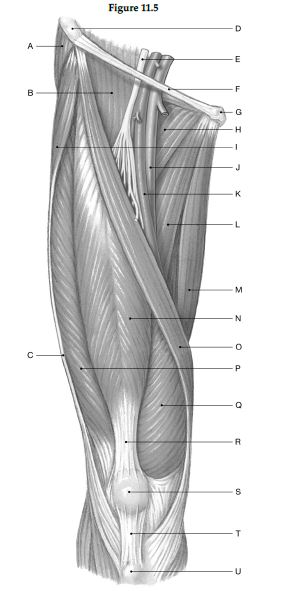Using the figure below, identify the labeled part.

1) Label A: ______________________________
2) Label B: ______________________________
3) Label C: ______________________________
4) Label D: ______________________________
5) Label E: ______________________________
6) Label F: ______________________________
7) Label G: ______________________________
8) Label H: ______________________________
9) Label I: ______________________________
10) Label J: ______________________________
11) Label K: ______________________________
12) Label L: ______________________________
13) Label M: ______________________________
14) Label N: ______________________________
15) Label O: ______________________________
16) Label P: ______________________________
17) Label Q: ______________________________
18) Label R: ______________________________
19) Label S: ______________________________
20) Label T: ______________________________
21) Label U: ______________________________
1) Gluteus medius
2) Iliacus
3) Iliotibial tract
4) Anterior superior iliac spine
5) Femoral nerve
6) Inguinal ligament
7) Pubic tubercle
8) Pectineus
9) Tensor fasciae latae
10) Femoral vein
11) Femoral artery
12) Adductor longus
13) Gracilis
14) Rectus femoris
15) Sartorius
16) Vastus lateralis
17) Vastus medialis
18) Quadriceps tendon
19) Patella
20) Patellar ligament
21) Tibial tuberosity
You might also like to view...
Which of the following are types of papillae on the tongue that contain taste buds?
A) palatine and circumvallate B) fungiform, circumvallate, and filiform C) circumvallate and filiform D) fungiform and circumvallate
The area of the brain stem involved in controlling forced expirations is called (the)
A) pneumotaxic center. B) dorsal respiratory group. C) ventral respiratory group. D) apneustic center. E) None of the answers are correct.
Which of the following tubes does not enter or exit the pharynx?
a. larynx b. esophagus c. auditory tubes d. all of these tubes enter or exit the pharynx
Murphy's eye, an opening on the distal side of an ET tube, allows ventilation to occur:
A) whether the tube is in the trachea or in the esophagus. B) even if the tip of the tube is occluded by blood or mucus. C) if the tube is inserted into the right mainstem bronchus. D) even if the ET tube does not enter the patient's trachea fully.